Analysis of atmospheric effects on the continuous variable quantum key distribution
Tao Liu(刘涛) Shuo Zhao(赵硕) Ivan B.Djordjevic Shuyu Liu(刘舒宇) Sijia Wang(王思佳)Tong Wu(吴彤) Bin Li(李斌) Pingping Wang(王平平) and Rongxiang Zhang(张荣香)
1Department of Electronic and Communication Engineering,North China Electric Power University,Baoding 071003,China
2Hebei Key Laboratory of Power Internet of Things Technology,North China Electric Power University,Baoding 071003,China
3Baoding Key Laboratory of Optical Fiber Sensing and Optical Communication Technology,
North China Electric Power University,Baoding 071003,China
4Department of Electrical and Computer Engineering,University of Arizona,1230 E Speedway Blvd.,Tucson,Arizona 85721,USA
5College of Physics Science and Technology,Hebei University,Baoding 071002,China
Atmospheric effects have significant influence on the performance of a free-space optical continuous variable quantum key distribution (CVQKD) system. In this paper, we investigate how the transmittance, excess noise and interruption probability caused by atmospheric effects affect the secret-key rate(SKR)of the CVQKD.Three signal wavelengths,two weather conditions, two detection schemes, and two types of attacks are considered in our investigation. An expression aims at calculating the interruption probability is proposed based on the Kolmogorov spectrum model. The results show that a signal using long working wavelength can propagate much further than that of using short wavelength. Moreover,as the wavelength increases,the influence of interruption probability on the SKR becomes more significant,especially within a certain transmission distance. Therefore, interruption probability must be considered for CVQKD by using long-signal wavelengths. Furthermore,different detection schemes used by the receiver will result in different transmission distances when subjected to individual attacks and collective attacks,respectively.
Keywords: atmospheric effect, continuous variable key distribution, free space quantum communication,secret-key rate
1. Introduction
Quantum communication in free-space optical (FSO)channels has recently attracted much attention due to the lowtransmission loss and flexible installation.[1]It has become an important way to realize a global quantum communication network.[2]However, when the optical beam propagates over the atmosphere, it is inevitably affected by atmospheric effects such as absorption, scattering, and turbulence. Turbulence caused by atmospheric motion and heating is the main factor affecting the performance of the FSO quantum communication system. It can lead to random fluctuation of the atmospheric refractive index, which can cause light intensity flickering,beam drift,angle-of-arrival fluctuations,phase fluctuations,and beam expansion. All of these natural but troublesome atmospheric occurrences affect optical signals as they propagate through the atmosphere. Communication may even be interrupted due to the transmittance change,[3,4]in particular in strong turbulence regime.
The theory of classical light transmission through the atmosphere is well developed.[5–7]Some progress in the theory of free space transmission of quantum light is also obtained.Vasylyevet al.[8]derived the consistent probability distribution of transmittance for three channel models of the beam wandering model, elliptical beam model, and the model with the law of total probability by step-by-step inclusion of various atmospheric effects such as beam wandering,beam broadening and deformation of the beam into elliptic form, beam deformations into arbitrary forms. Chaiet al.[9]investigated the atmospheric effects on the excess noise in FSO continuous variable quantum key distribution(CVQKD)and analyzed the excess noise tolerance of systems with diverse modulations, which provided a certain theoretical basis for studying the effect of excess noise on the performance of secret-key rate (SKR). Zhaoet al.[10]investigated intensity scintillation effects, atmospheric transmittance, and phase noise caused by atmospheric turbulence on communication performance in the satellite-to-ground CVQKD system-based orthogonal frequency division multiplexing system.These studies[8–10]carefully investigated the influence of atmospheric turbulence on communication performance, but they did not cover the impact of interruption probability on the quantum communication performance,which is also caused by atmospheric turbulence. Wanget al.[11]considered the interruption probability in their study of the effects of atmospheric scattering and turbulence on CVQKD SKR. However, even though they determined the interruption probability to have an impact on the SKR,the corresponding analysis was not carried out. Besides,the studies so far considered only a single wavelength for transmission. It is well known that,for the classical laser FSO communication system,signals with different wavelengths get differently affected by the atmospheric effects.[12]Thus, it is necessary to investigate the atmospheric effects on the FSO CVQKD system identify the most suitable wavelength showing better tolerance to various atmospheric effects. Also, for the classical laser FSO communication system, several spectrum models,including the Kolmogorov spectrum model,the von K´arm´an spectrum model, and the modified von K´arm´an spectrum model, can be used to theoretically investigate the effect of turbulence on optical signals.[13]Compared to the von K´arm´an spectrum model and modified von K´arm´an spectrum model, the Kolmogorov spectrum model is simple thus it is more widely used. However, research is difficult to find on the effect of atmospheric turbulence on the performance of FSO quantum communication system by using the Kolmogorov spectrum model.[11,14]
From the reported studies[15–17]one can see that, the wavelengths around 810 nm are widely used in the satelliteto-ground quantum communication systems,the 1550 nm can be utilized to overcome the background noise due to sunlight in daylight, and the 3800 nm wavelength has the advantage of being affected less by atmospheric effects compared to the 810 nm and 1550 nm wavelengths. Therefore,in this paper, the three wavelengths (810 nm, 1550 nm, and 3800 nm)are used in the investigation of atmospheric effects on the FSO CVQKD system with the goal to identify the wavelength region more tolerant to various atmospheric effects.Two weather conditions,homodyne and heterodyne detection cases, and individual and collective attacks are considered in our study. A CVQKD model for transmission over free-space optical channel is established firstly and then it is used to analyze the simultaneous effects of transmittance, excess noise and interruption probability on the SKR of the CVQKD. A formula to calculate the interruption probability is achieved based on the Kolmogorov spectrum model and used in the simulation. In clear weather, the results show that, the SKR decreases with the increase of transmission distance for all three wavelengths,but the transmission distance at 3800 nm is much larger than that of 810 nm and 1550 nm at the same SKR.With the increase of wavelength,the effect of interruption probability on the SKR becomes more significant especially within a certain range of transmission distance, such as at the range of 10 km–100 km for 3800 nm wavelength. Thus, this effect must be considered for CVQKD by using long-signal wavelength. Moreover,to achieve longer transmission distance,the receiver should use homodyne detection in case of collective attacks, whereas heterodyne detection is recommended if the CVQKD system is under individual attacks.Similar results are obtained in fog except that the transmission distance is much shorter than that found in clear weather.
2. Free-space optical CVQKD transmission model
The FSO CVQKD system is a flexible system that can be easy installed and repositioned compared to the fiber-based solution, but affected by atmospheric effects, so it is essential to investigate the effects of atmosphere on the SKR. An entanglement-based CVQKD model with Gaussian modulation is observed and illustrated in Fig. 1. The sender (Alice)and receiver(Bob)share a pair of two-mode squeezed entangled states generated by the Einstein–Podolsky–Rosen(EPR)entangled source with varianceV. One mode of the entangled stateAis measured by Alice using homodyne detection,
wherexAandpAare the quadratures of the entangled stateA,respectively. Meanwhile, another entangled stateB0, which is transmitted to Bob through an atmospheric channel with a transmittanceTand excess noiseε, becomes modeB1after transmission.The channel extra noise observed from the channel input point of view is given byχline=1/T-1+ε.
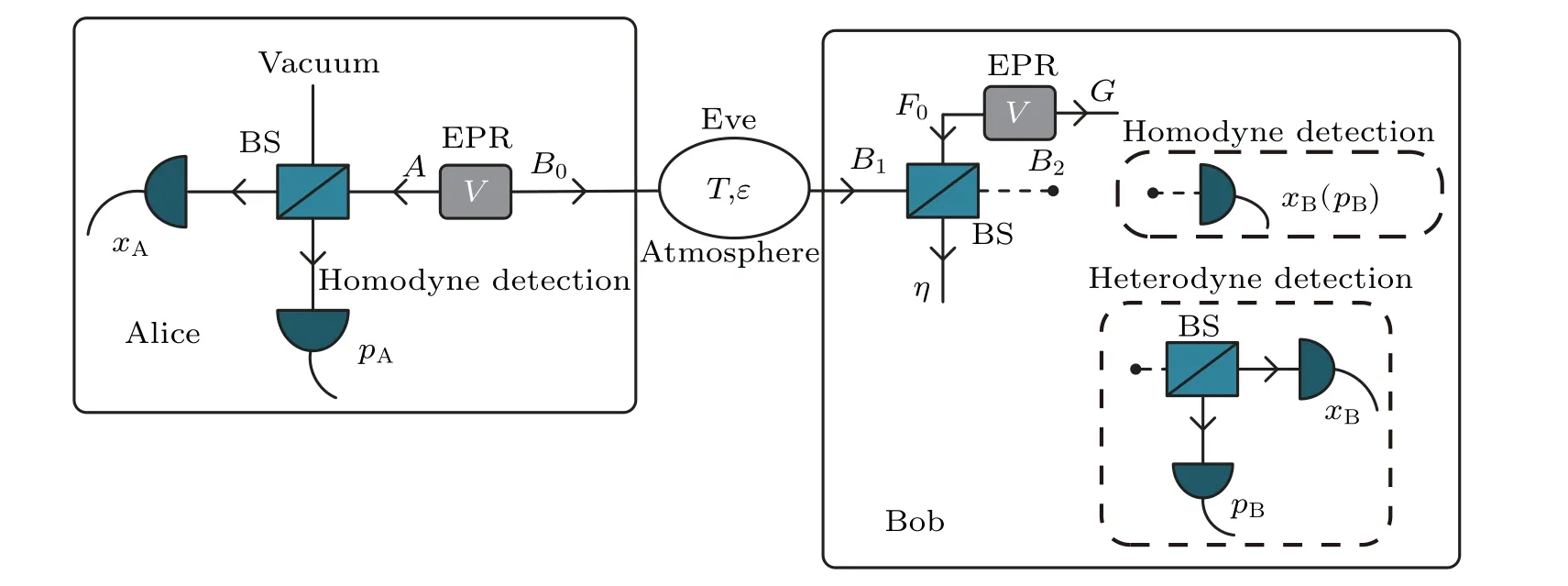
Fig.1. Entanglement-based CVQKD model. BS,beam splitter.
Bob’s detector efficiency is modeled by a beam splitter with transmissionη, while its electronic noisevelis modeled by an EPR state of variancev. As shown in Fig. 1,theF0mode is coupled into the second input port of the beam splitter.νis given byvhom=ηχhom/(1-η) andvhet=(ηχhet-1)/(1-η)for homodyne and heterodyne detection, respectively, whereχhom= ((1-η)+vel)/ηandχhet=(1+(1-η)+2vel)/ηare the total noise of the actual homodyne and heterodyne detection, respectively. When the communication is completed, Alice and Bob perform classical data processing to obtain the final, secure quantum key through processes such as information reconciliation and privacy amplification.
Assuming that Alice and Bob adopt the reverse reconciliation approach,the SKR of the free-space CVQKD system with Gaussian modulation in the case of individual attacks and collective attacks is calculated as follows.
(1)The secret key rate for the case of collective attacks is given by[11]

wherePis the probability of communication interruption,βis the reconciliation efficiency,IABis the Shannon mutual information of Alice and Bob,andχBEindicates the upper limit of the amount of information Eve can obtain from Bob,[18,19]which can be expressed as

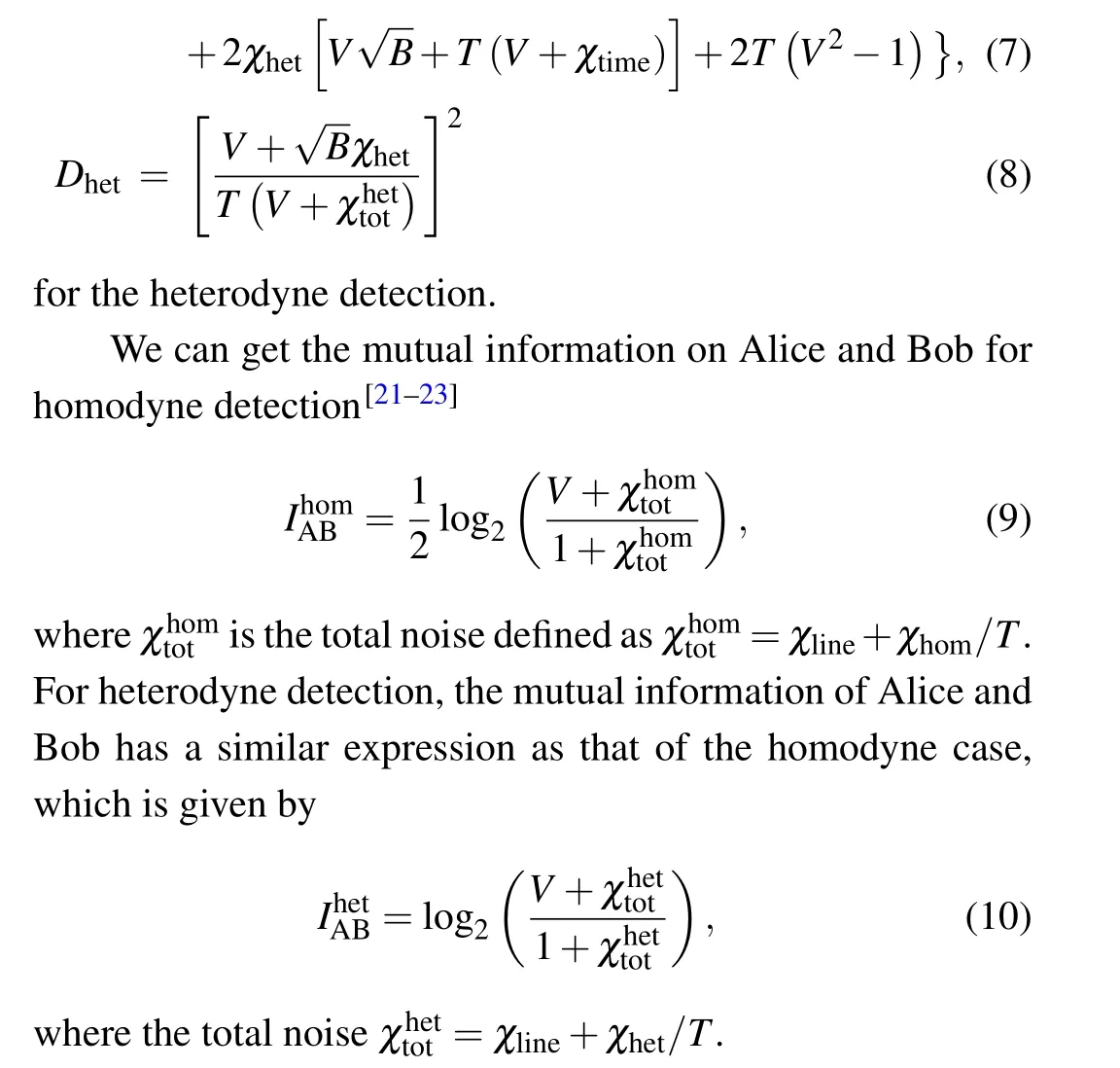
(2) The secret key rate for the case of individual attacks is expressed as

whereIABhas the same expressions as Eqs. (9) and (10) for homodyne and heterodyne detections,respectively.
TheIBEis the maximum information on Bob’s key available to Eve and is limited by the Shannon bound, which can be calculated by[21]

It can be seen from Eqs.(1)and(9)that the SKR of the freespace CVQKD system is related to the interruption probabilityP, the reconciliation efficiencyβ, the Shannon mutual information between Alice and BobIAB,and the upper limit of the amount of information Eve obtained from Bob, which is denoted asχBEandIBEfor collective and individual attacks,respectively.Pis dominated by the fluctuation of the beam arrival angle due to the atmospheric turbulence,which can be reduced by the employment of the beam tracking system. In addition,IABvaries with the transmittanceTwhich is determined by the absorption and scattering of the molecules and aerosol in the atmosphere, and with the excess noiseεcaused by the pulse arrival time fluctuation because of the atmospheric turbulence.Since the atmospheric effects have a significant influence on the SKR,the next section will present a detailed analysis to help clarify the causes of the effects. In addition because the atmospheric effects are wavelength-dependent and affect the transmission distance,the signal wavelength and transmission distance are set as two main variables in the analysis.
3. Atmospheric effects on free-space optical CVQKD system
3.1. Transmittance
Transmittance fluctuations can cause beam wandering,broadening, deformation, and scintillation, which will have a certain impact on the SKR.For horizontal path, the transmittance is given by[24]

In this paper, three different wavelengths of 810 nm,1550 nm and 3800 nm are chosen to study the atmospheric effects on SKR to select the wavelength region more tolerant to turbulence effects. Because all the wavelengths are within the atmospheric transmission windows,the contribution of absorption toα(λ)is extremely small.For that reason,Mie scattering dominates the total extinction coefficient which can be calculated by[25]
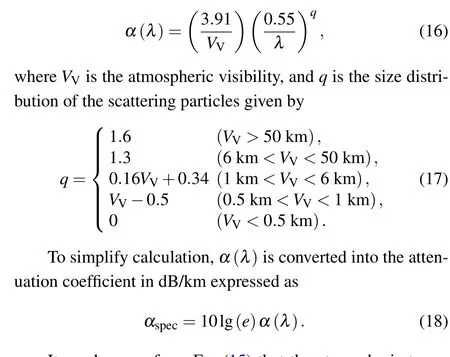
It can be seen from Eq. (15) that the atmospheric transmittance is related to the atmospheric attenuation coefficient.The relationship between the attenuation coefficient and visibility for different signal wavelengths is shown in Fig.2.
Figure 2 shows that the attenuation coefficient of the long-wavelength signal is smaller than that of the shorterwavelengths for the same visibility. Take visibility of 23 km and 4 km for example, which denote the clear weather and fog respectively,the corresponding attenuation coefficients are 0.06 dB/km and 0.64 dB/km for 3800 nm wavelength,whereas those for 810 nm wavelength are 0.45 dB/km and 2.92 dB/km.Therefore,it is better to use longer wavelengths from attenuation point of view.

Fig. 2. The atmospheric attenuation as a function of the visibility for different wavelengths.
3.2. Excess noise
The optical pulse is affected by the atmosphere in the time domain,causing the pulse arrival time fluctuation,which further leads to the phase fluctuation. This effect may bring excess noise to the CVQKD system. As noted in the preceding section’s analysis,the excess noise will affect the SKR.When the phase fluctuation is small enough,excess noise can be expressed as[26]

It can be found from Eq. (19) that, the excess noise is a function of height, distance and signal wavelength. Under weak turbulence conditions,we considerρta=1-2×10-14,VA=10 andT0=5×10-8s. The variation of excess noise varies with the height and distance at different wavelengths is summarized in Fig. 3. One can see from Fig. 3 that, under the same condition,excess noise at 810 nm,1550 nm and 3800 nm wavelengths are about 0.15, 0.04 and 6.83×10-3(expressed in shot noise unit,SNU),respectively. The excess noise of 3800 nm is two orders of magnitude lower than that of 810 nm. That is,much higher SKR can be achieved by using the 3800 nm wavelength compared to the 810 nm wavelength.
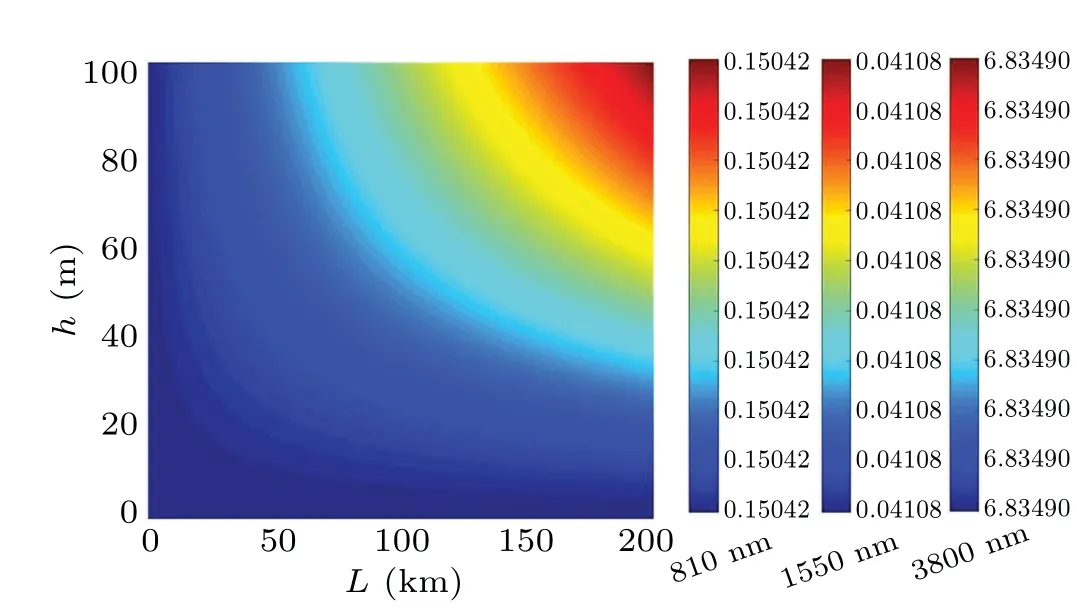
Fig. 3. Excess noise caused by phase fluctuation for different wavelengths.
3.3. Interruption probability
Atmospheric turbulence can lead to the fluctuation of a beam arrival angle,which can give rise to random jitter of the spot formed on the focal plane. When the angle of arrival fluctuation is too large, the spot on the focal plane cannot be in the receiving aperture, which will lead to communication interruption(see Fig.4).

Fig.4. Communication interruption due to the angle of arriving fluctuations.
The root mean square displacement of the lens can be calculated by

whereD(2b,L)is the phase structure function,bis the radius of the receiving lens,k=2π/λis the optical wave number,andλis light wavelength.

wheredcoris the diameter of the fiber aperture.
It can be seen from Eqs.(22)and(23)that the interruption probabilityPis related to the transmission distance,the signal wavelength, and the phase structure function of atmospheric turbulence. For the Kolmogorov spectrum model, which is widely used in the simulation of turbulence, the phase structure function used to calculatePis derived as following.
The Kolmogorov spectrum is expressed as
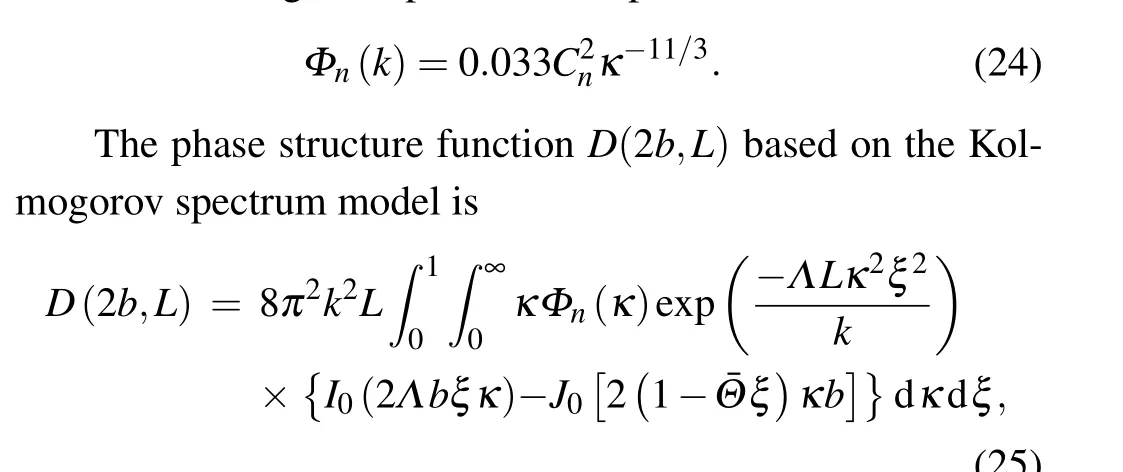
where ¯Θ=-L/FandΛ=2L/kW2are the non-dimensional output plane beam parameters.F=L(1+πW20/λL)is the front curvature radius.W0is the beam radius of the emitter.The receiving end beam radiusWcan be calculated by


Based on the Kolmogorov spectrum model, the interruption probabilityPis simulated as a function of distance in Fig. 5 for different wavelengths. Figure 5 shows thatPfor 810 nm,1550 nm and 3800 nm wavelengths is a monotonically increasing function of the distance. AlthoughPfor short-wavelength at 810 nm is smaller than that of long-wavelength at 3800 nm,the difference between them is rather small. Especially in the range of transmission distance is less than 60 km,Pof these two wavelengths are almost the same. Nevertheless,when the transmission distance exceeds 60 km, the difference ofPbetween the two wavelengths will increase gradually as distance increases. In that case, if we only consider the influence of interruption probability on SKR, the shorter wavelengths are preferable. However,if the transmittance and excess noise are also considered,the short wavelength may not be the optimal choice. Therefore,it is necessary to comprehensively analyze the effect of different wavelengths on the performance of the FSO quantum communication system.
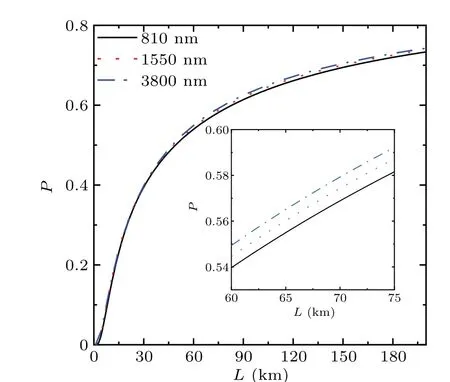
Fig. 5. The communication interruption probability varies depending on the distance capability of the different wavelengths.
4. Illustrative SKR results and discussion
In this section, the effects of the interruption probabilityP, transmittanceT, and excess noiseεon the CVQKD system are analyzed. Different weather conditions,such as clear weather and fog, are considered in our investigation. Based on the above CVQKD model,in case of individual attacks and collective attacks, the SKRs for different signal wavelengths are calculated when Bob uses homodyne detection and heterodyne detection, respectively. The parameters used in the simulation are summarized in Table 1.
For homodyne detection,as shown from Fig.6 the setup and operational mode must follow certain guidelines. The following is a summary of our analyzes.

Table 1. The parameters setting of SKR analysis with different wavelengths.
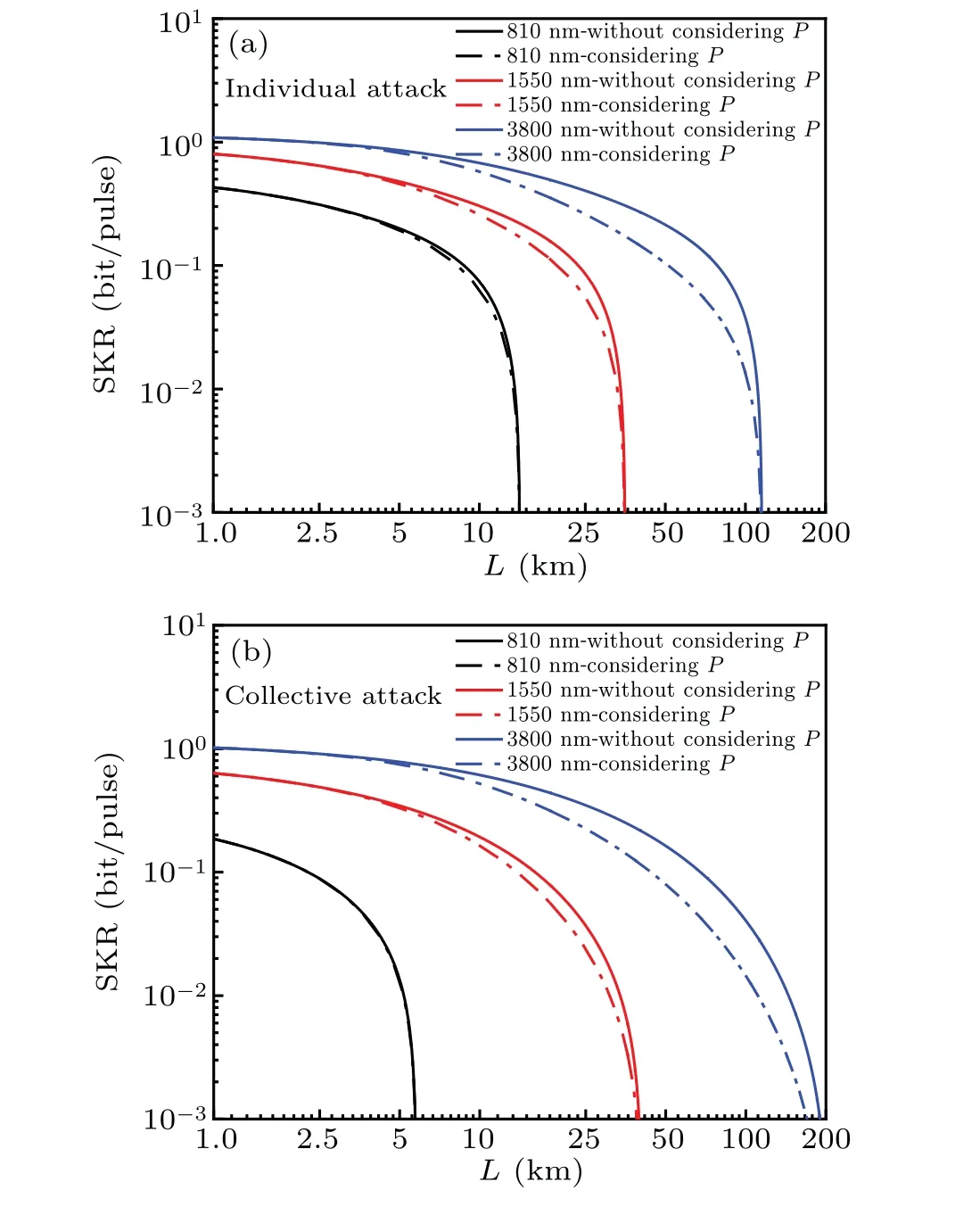
Fig.6. Relationship between SKR and distance in case of(a)individual attacks and (b) collective attacks for homodyne detection in clear weather.
(1)In the case of individual attacks and collective attacks,all the SKRs for different signal wavelengths are monotonically decreasing functions of the transmission distance,as expected. However, compared to 810 nm wavelength region,which is widely used in the satellite-to-ground quantum communication systems,[27,28]and 1550 nm which is utilized to overcome the background noise due to sunlight in daylight,[16]the 3800 nm-based CVQKD has the longest propagation distance at the same SKR.For example,in case of individual attacks,when the SKR is 10-3bit/channel use,the propagation distance of the 3800 nm wavelength signal is 115 km, which is 100 km and 80 km longer than that of 810 nm and 1550 nm,respectively. While under collective attacks, the propagation distance of 3800 nm reaches 190 km, which is 184 km and 150 km longer than that of 810 nm and 1550 nm,respectively.
Based on the results shown in Section 3,the signal with a long wavelength has a smaller excess noiseε,and much larger transmittanceTin comparison with those of the shorter wavelengths signals. Though the interruption probabilityPof the former is higher than that of the latter,the difference between them is rather small. For this reason, a 3800 nm wavelength signal propagates at much longer distances compared to the 810 nm and 1550 nm wavelengths.
(2) The effect of interruption probabilityPon the SKR for different wavelengths is different. For example, with and without consideringP,the SKRs of 810 nm are almost same.Thus,it is reasonable to neglect the influence ofPin the simulation when we use a short wavelength signal. This is done to maintain a simplicity that is both efficient and easy to work with. However,when wavelengths increase,thePeffect needs to be considered. Consider a 3800 nm wavelength as an example. Figure 6 clearly shows that not consideringPdoes not provide the realistic estimate of the achievable transmission distance for a given SKR.To overcome this problem the beam tracking is necessary.
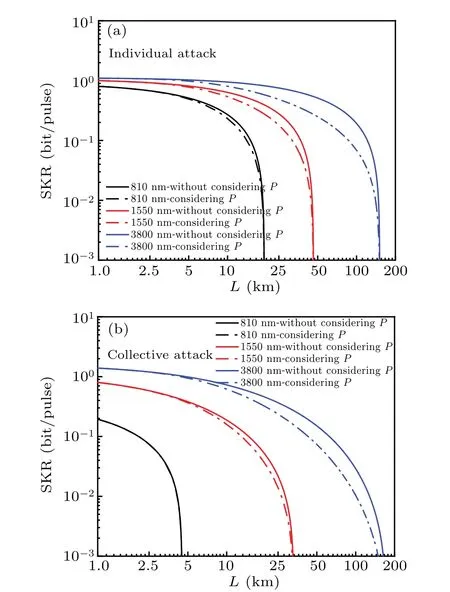
Fig.7. Relationship between SKR and distance in case of(a)individual attacks and (b) collective attacks for heterodyne detection in clear weather.
In the case of heterodyne detection,someone may notice that the trends are the as that of homodyne detection. As illustrated in Fig. 7, the SKRs for different wavelengths also monotonically decreasing functions of transmission distance.Similarly,much longer transmission distance can be achieved at 3800 nm compared to the short wavelengths at the same SKR. The effects of interruption probabilityP, transmittanceT,and excess noiseεon the SKR for heterodyne detection are also similar to those of homodyne detection.

Fig.8. Relationship between SKR and distance in case of(a)individual attacks and(b)collective attacks for homodyne detection in fog.
Comparing Figs. 7 and 6 shows that, in the case of collective attacks, CVQKD signals employ homodyne detection can transmit farther than that of heterodyne detection under conditions that uses the same wavelength. But in the case of individual attacks,the propagation distance of heterodyne detection is farther than that of the homodyne detection under the same conditions. Therefore, in the practical application, Bob should select an appropriate detection mean based on the type of attack the Eve is conducting.
The demonstration of the above theoretical model and corresponding analysis is also suitable for other types of weather conditions,and the SKR is calculated under the same conditions as those used above, except for assuming the signals are transmitted in the fog. The results summarized in Figs. 8 and 9 show that the interruption probabilityPhas little effect on the performance of the quantum communication system in the presence of fog. As expected, the achievable transmission distance is much smaller in fog compared to that in clear weather condition.
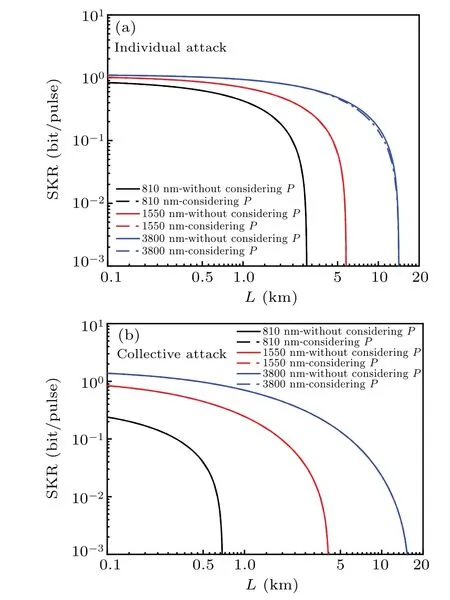
Fig.9. Relationship between SKR and distance in case of(a)individual attacks and(b)collective attacks for heterodyne detection in fog.
5. Concluding remarks
This paper presents a study on how SKR in CVQKD get affected by the attenuation, excess noise, and interruption probability caused by the atmospheric effects at 810 nm,1550 nm, and 3800 nm wavelengths, by using either homodyne or heterodyne detection schemes, under individual attacks and collective attacks, in clear weather and fog. An FSO CVQKD transmission model has been established firstly.Then, the transmittance, excess noise and interruption probability have been calculated for 810 nm,1550 nm,and 3800 nm signal wavelengths. An equation has been given and utilized in the calculation of the interruption probability based on the Kolmogorov spectrum model. We carried out a detailed analysis of the transmittance effects, excess noise, and interruption probability on the SKR. The SKR results indicate that the longest wavelength under study (3800 nm) we can obtain a higher SKR than that of shorter wavelengths for the same propagation distance. Observed differently, for a given SKR much longer transmission distance can be achieved at 3800 nm. On the other,the interruption probability effect appears to be slightly higher at longer wavelengths. Because the interruption probability reduces the SKR at any wavelength,the beam tracking system should be used to solve for this problem. Moreover, when Eve applies the collective attacks and for the same wavelength, a system employing homodyne detection can achieve longer distance than corresponding system using the heterodyne detection. However, this behavior has been reversed when Eve applies the individual attacks. Similar conclusions have been found for clear weather and fog.To conclude, in a practical application, longer wavelengths should be used,such as 3800 nm,given that longer transmission distances can be achieved for the same SKR. However,Bob should select an appropriate detection scheme based on the type of the attack conducted by Eve.
Acknowledgements
Project supported by the National Natural Science Foundation of China (Grant No. 62071180) and Fundamental Research Funds for the Central Universities, China (Grant No.2020MS099).
- Chinese Physics B的其它文章
- A design of resonant cavity with an improved coupling-adjusting mechanism for the W-band EPR spectrometer
- Photoreflectance system based on vacuum ultraviolet laser at 177.3 nm
- Topological photonic states in gyromagnetic photonic crystals:Physics,properties,and applications
- Structure of continuous matrix product operator for transverse field Ising model: An analytic and numerical study
- Riemann–Hilbert approach and N double-pole solutions for a nonlinear Schr¨odinger-type equation
- Diffusion dynamics in branched spherical structure

